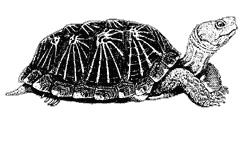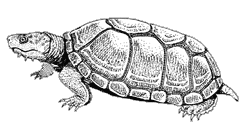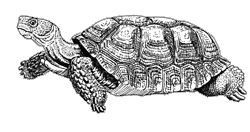Terrapene
Western Box Turtle (Terrapene ornata)
Order: Testudines
Family: Emydidae (subaquatic turtles)
Other common names: yellow box turtle
Spanish name: tortuga de caja
Distinguishing Features
The words Terrapene ornata translate to “ornate (patterned) small turtle,” which aptly describes this 6 inch (15 cm) long, colorful, terrestrial turtle. Both the high-domed carapace (upper part of the shell) and hinged plastron (lower part) are black or brown with radiating yellow lines and dots. The male has an orange to reddish iris, reddish spots on the foreleg, and an inwardly curved nail on each hind foot. The shells of older animals often lose their pattern, becoming a uniform pale green or straw color.
Range

This turtle is found as far north and east as South Dakota, Michigan, and Indiana, south through southeast Arizona, New Mexico and Texas into northern Mexico.
Habitat
The western box turtle of grasslands, found in treeless plains to gentle hills with grass or low bushes and sandy soils, though occasionally it is found in desert habitats. It tends to create shallow burrows in loose soils; it will also use mammal burrows and bannertail kangaroo rat mounds. These burrows are used to avoid temperature extremes and reduce desiccation.
Life History
The western box turtle is omnivorous, feeding on insects (especially beetles), berries, leaves, fruits, and sometimes carrion. It reproduces from March to November, laying 2 to 8 eggs per clutch. Breeding strongly correlates with rainfall.
Comments
Box turtles can be either timid or pugnacious, retreating into their tough
shells or defending themselves with strong beaks. ![]()
Sonoran Mud turtle (Kinosternon sonoriense)
Order: Testudines
Family: Kinosternidae (mud and musk turtles)
Spanish name: tortuga del agua
Distinguishing Features

The Sonoran mud turtle is medium sized (up to 6¼ inches, 16.5 cm) with a smooth, high-domed carapace (upper part of the shell). The name Kinosternon means moveable chest, which refers to the hinged plastron (lower part of shell). The Sonoran mud turtle can be distinguished from the yellow mud turtle by noting its non-enlarged ninth marginal scute (indicated by the arrow on the illustration). The same scute on a yellow mud turtle is usually taller than it is wide. (Scutes are the large, hornified plates that cover the shell.) This turtle generally has a uniform light brown or yellowish-brown shell. The shell is often partially covered with algae. The head and neck have light and dark marks; there are several barbels (fleshy projections) located under the chin. Males have tails with a hooked tip and 2 groups of thickened scales on the inner surfaces of the hind legs.
Range
This species is widespread from central Arizona to Durango, Mexico and southeastern California to west Texas up to 6700 feet (2042 m).
Habitat
A stream dweller, the Sonoran mud turtle is usually found in springs, creeks, ponds, and intermittent streams. Though occasionally found in desert and grassland areas, this turtle usually inhabits oak to pinyon-juniper woodlands or pine-fir forest.
Life History
Although the Sonoran mud turtle favors invertebrate prey such as crustaceans,
insects, and worms, it also eats some fish and frogs. It is also known
to scavenge. Females lay 2 to 9 eggs from May to September.![]()
Desert Tortoise (Gopherus agassizii; also Xerobates agassizii)
Order: Testudines
Family: Testudinidae (tortoises)
Spanish names: tortuga del desierto, tortuga de los cerros, tortuga del monte
Distinguishing Features
Tortoises differ from other turtles in having cylindrical and elephantine hindlegs and short, broad, club-shaped feet. The genus Gopherus also has flattened forelimbs for digging. The adult desert tortoise can measure up to 14 inches (35.5 cm) in length; the hatchlings are only about 2 to 2¼ inches (5 to 6.5 cm) long. The carapace is brown to gray and rounded. The yellowish plastron is not hinged and is connected to the carapace at the sides. The male’s plastron is concave at the posterior to accommodate the rounded carapace of the female during copulation. The female’s plastron is flat. Like all turtles it is toothless; the large tongue helps push food back in the mouth. There are no visible ears.
Distribution

The desert tortoise lumbering over rocks on a hillside among foothills palo verdes and saguaros is the modern representative of a lineage that began 50 million years ago in early Tertiary tropical forests long before the Sonoran Desert existed. Today, the desert tortoise occurs from tropical areas in northern Sinaloa and southern Sonora northward through the Sonoran Desert in central Sonora and western Arizona to the Mohave Desert in southeastern California, southwestern Utah, and southern Nevada. The climates in these areas range from tropical in southern Sonora to temperate in southern Nevada. Tortoises inhabit vegetation ranging from tropical deciduous forest and thornscrub in the south to various Sonoran and Mohave desert communities in the north, to desert grassland in Arizona.
Ecology
The ecology of desert tortoises in the Mohave Desert differs in important details from that of its Sonoran Desert and tropical relatives. Tortoises in Nevada and Utah typically live in relatively flat valley bottoms and construct extensive burrows up to 35 feet (11 m) in length that are often shared with other tortoises. These tortoises excavate their own dens, allowing the populations to reach the highest known densities for their species. Tortoises in the Sonoran Desert in Arizona live on rocky, boulder-strewn hillsides and are mostly solitary. Burrows are shallow and casually made; they also make use of existing crevices or depressions. Populations of these tortoises are limited by available natural shelter sites.
Desert tortoises are well-adapted to withstand the extended dry periods typical of deserts. Although they extract much of their water from the plants they eat, tortoises drink prodigiously from temporary rain pools. They have large urinary bladders that can store over 40 percent of their weight in water and urinary wastes. Urea is precipitated as solid uric acid in the bladder, freeing additional water and useful ions. During periods of inactivity in winter (hibernation) or summer (estivation), metabolic rates, digestion, and water loss from defecation and urination are greatly reduced. As soon as fresh water is available, the solid urates are eliminated from the bladder. Well-hydrated tortoises are able to eat dried plants and store fats in the body. Dehydrated tortoises are physiologically stressed and cannot digest dry plant foods.
Tortoises are generally active in times when water stress is reduced (early morning or evening); they can be diurnal or crepuscular depending on temperature and season. Mohave tortoises are mostly active in the spring months from February to May. Sonoran tortoises are primarily active in the summer monsoon months from July to October. Estivation during the hottest, driest parts of the summer helps conserve water because burrows or rockshelters are relatively cool and relative humidity of up to 40 percent reduces evaporation. Without extensive burrows it is unlikely that tortoises could survive the dry Mohave Desert summers. The common defensive behavior of emptying the bladder when molested or handled can have serious consequences in drier periods.
Desert tortoises are herbivores, although occasionally carrion, insects, rocks, bones, and soil are ingested. The intestines are elongated and can digest the cellulose tied up in plant fiber. In the Mohave Desert, fresh spring annuals are the primary food plants. In the Sonoran Desert, tortoises eat mostly grasses, globemallows, desert vine (Janusia gracilis), and many other plants. Spring annuals are eaten fresh in April and dry from May to October. In August and September, Sonoran tortoises supplement their diets with summer annuals, especially spurges (Euphorbia spp.) and verdolaga (Portulaca oleracea), and prickly pear (Opuntia spp.) fruits.
The social behavior of tortoises is relatively straightforward—males fight all adult males and court all adult females they encounter. Mating occurs throughout the summer, although females lay eggs in late June or early July in the Sonoran Desert. Mohave Desert tortoises typically lay a second clutch of eggs at the end of the summer. Retention of viable sperm in the cloaca of the female for at least 2 years is an excellent survival strategy in non-colonial animals: it ensures fertilization during extended droughts when males are less active or populations crash. The eggs contain all of the water and nutrients necessary for complete development of the hatchlings. Hard egg shells retard desiccation. The normal incubation period of about 90 days in the summer can be much longer later in the year as temperatures fall.
Tortoises are long lived. In the Sonoran Desert, free-ranging adults live about 35 or 40 years and spend their lives within a few miles of where they hatch. Sexual maturity is attained at 13 to 15 years, at which point the carapace is about 7 inches (18 cm) long. Growth is controlled by environmental conditions and amount and quality of food. Captives with unlimited water and high protein diets grow and mature faster than wild animals. Ages can be estimated using the annual rings on the epidermal scutes, although tortoises may not grow in especially severe years, and the rings are worn off in older animals. Few hatchlings survive to maturity except during a series of unusually wet years.
In the Mohave Desert, populations have declined in response to habitat destruction, a debilitating upper respiratory disease, and predation of young by ravens. In 1990, this population was designated as threatened by the United States Fish and Wildlife Service. In Arizona, most populations of Sonoran tortoises studied are healthy. However, there are serious threats to desert tortoise populations in Arizona and Sonora as grasses, especially the exotic red brome (Bromus rubens) and buffelgrass (Pennisetum ciliare), introduce fire into vulnerable Sonoran desertscrub and thornscrub habitats.
No matter where they live, desert tortoises are protected. They cannot be collected, killed, transported, bought, sold, bartered, imported, or exported from Arizona without authorization by the Arizona Game and Fish Department. Tortoises held in captivity before protection was implemented, and their progeny, may be possessed legally. Captive tortoises should not be released into the wild for a variety of reasons: they may transmit disease to the wild population; they may disrupt natural population levels and/or social structure; they may not survive due to maladaptation resulting from long-term captivity and captive diets.
For these reasons, the Desert Museum has established a tortoise adoption program
which places un-wanted or surplus captive tortoises with qualified private
custodians. This reduces incentive to collect them from the wild and helps
to satisfy some people’s interest in having them. Applicants for the program
are carefully screened for attitude and aptitude. The custodian must comply
with ASDM standards of housing, care and diet before receiving a tortoise,
which remains the property of the State of Arizona. The program is not
a pet program, but rather a captive tortoise “recycling” effort to insure
that tortoises already in captivity are provided the best life possible.
![]()










